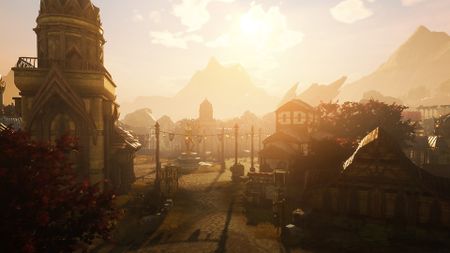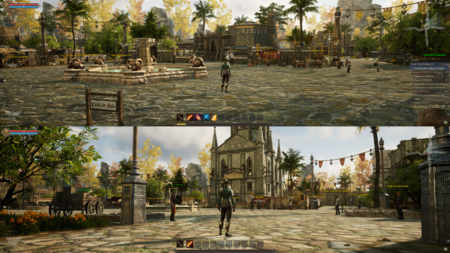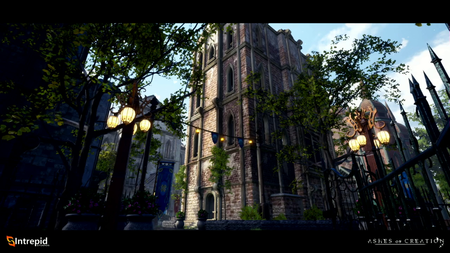“Unique node buildings”的版本间差异
(Created) 标签:新重定向 |
(Add section) |
||
| (未显示同一用户的1个中间版本) | |||
| 第1行: | 第1行: | ||
| − | + | {{Unique node buildings}} | |
| + | |||
| + | == Node types == | ||
| + | |||
| + | {{Node types}} | ||
| + | |||
| + | == Node development == | ||
| + | |||
| + | {{Node development}} | ||
| + | |||
| + | == See also == | ||
| + | |||
| + | * [[Node buildings]] | ||
| + | * [[Freehold buildings]] | ||
| + | * [[Player housing]] | ||
| + | * [[Architecture]] | ||
| + | |||
| + | == References == | ||
| + | |||
| + | <references/> | ||
| + | |||
| + | [[Category:Nodes]][[Category:Buildings]] | ||
2019年5月25日 (六) 13:24的版本
Each node type has a unique service building associated with it that can be activated at
[[{{{2}}}|⧼{{{2}}}⧽]] (階段 3) of node advancement.[2] The unique building plays a central role in the progress of civilization for a server.[3]
節點種類

Nodes exist all throughout the world and the location of said node will determine its type; but this type will be... seen at the first stage of development when the first stage when a node propagates real-time assets in the world; is basically these NPCs, these merchants that come into an area and they offer services and/or of stores or whatever the deal may be. You will see the flavor of the node from those merchants. So if it's a military node you'll see military people. If it's... an economic node you'll see merchants. If it's a scientific one you'll see scholars; and if it's a divine one you'll see priests and clerics. So players will have a very firm understanding of which node is which type in order to know how they want to progress.[4] – Steven Sharif
據點會被分配為四種據點種類的其中一種,不同種類的據點都會有其獨特的專業。[5]
- 玩家能夠在據點發展成第一階段(Expedition)時,透過辨別據點內的NPC從而識別該據點的種類。[4]
| 據點種類.[5] | 獨有專業[5] | NPCs.[5] |
|---|---|---|
| 神聖據點 | 信仰和技能/裝備強化 | 牧師 |
| 經濟據點 | 交易和商貿 | 商人 |
| 軍事據點 | 戰鬥和職業訓練 | 守衛 |
| 科技據點 | 工匠和建築 | 學者 |
Ashes of Creation allows you, the player, to decide the fate of the world around you. With each Node Type, you can change the flow of resources and goods in the world. Will you grow the largest Economic Metropolis and help guide the riches of Verra, or will you choose another path unlocking new stories filled with allies and enemies?[3]
For example, if a level 4 Scientific Node is destroyed, it will become a Level 0 Scientific Node. It will never be any other Node Type other than a Scientific Node. The location of these Types relates to the influences of the area around the Node.[5] – Margaret Krohn
Node development

The layout and architecture within a Node’s development area are determined by influential race. For example, a stage 3 Node with the majority of player contribution being Py'rai would have a Py'rai village with Py'rai architecture. Most NPCs would be Py'rai elves, and offer questlines within the Py'rai narrative.[5] – Margaret Krohn
Each player’s contributed experience is flagged with their character race and other identifiers. When a Node advances, the race with the highest experience contribution determines the Node’s style and culture. This style and culture change can happen at every Node Stage. For example, if a Node advances to Level 2 - Encampment Stage and 51% of all experience was earned by Ren’Kai players, the Node will be a Level 2 Ren’Kai Node. If that same Node advances to a Level 3 - Village Stage Node, but the Py'Rai contributed 62% of all the experience earned, then the Node will be a Level 3 Py'Rai Node.[6] – Margaret Krohn
節點佈局與風格 is determined by several factors:[7][8]
- The way that the node system is built is that they can exist across a spread of 18 biomes, but at the same time have to represent the cultural influence of these cultures that are intrinsically a part of a specific biome.[9] – Steven Sharif
- Environment (biome) and location of the node.[9][7][8]
- Nodes will adjust the local topography to fit the aesthetic and mechanical requirements of the node.[10]
- Currently the way that the platform system is set up, is it's capable of adjusting the topography of the node's footprint, regardless of the surrounding terrain. So the reason for that is we want to have flexibility in the presentation of the node's layout and how it is essentially both from an aesthetic standpoint as well as a mechanical standpoint with node sieges- how it's constructed and that construction should have the ability to take on a variance of different types of topography. So it shouldn't be dependent on the surrounding area. Now that's not to say that the surrounding area isn't going to have some influence over. So for example... we're experimenting a little bit with the platform tech and putting up a node up against the side of a mountain or on the edge of a cliff or something that has a beautiful vista. Those are things that we're going to test out obviously as we continue to work on the node tool and how that platform system works, but the idea is to have the node independent of the surrounding terrain.[10] – Steven Sharif
- Some parts are determined by the area it's in. Some parts are determined by the type it is. Some parts are determined by the race it is; and then the rest of it is determined by the mayor.[8] – Jeffrey Bard
- Race that contributed the highest percentage to the node's advancement will alter the racial appearance of its buildings, NPCs, and props.[11][12][7][6][8][13][14]
- All nodes, whether they're associated with a castle or associated with normal node structure, has cultural influences that replicate over to the buildings that are produced and the NPCs that are present.[16] – Steven Sharif
- The rest is determined by the node's mayor.[8]
- It should be possible for a node to complete several building projects within a mayor's one month term in office.[17]
- Q: How long would you say it will take players on average to fill/build up a node completely from wilderness to metropolis?
- A: It's one thing to get a node to a certain level: it's another thing to develop the node; and I can't really give you an on-average expectation, because there's a lot of variables at play. There's how many citizens does the node have attracted to it; what's the type of traffic that the node is attracting to it based on things like its tax rates, or the specialization that it chose to spec into, based on the building types it's chosen to build. All of those things are variables that can affect the quote-unquote "average build-out time" of a particular node. So it's difficult to give you an average when there's so many variables along those lines. But the idea is that if there is a particular project that players are interested in in developing based on the node stage, that they would have the ability to complete several of those projects as within a single term of a mayor; and a term of a mayor is one month.[17] – Steven Sharif
其他
引用
- ↑ 直播, 2018-09-01 (36:28).
- ↑ 直播, 2023-08-31 (56:18).
- ↑ 3.0 3.1 Know Your Nodes: Economic Node Type.
- ↑ 4.0 4.1 直播, 2017-05-04 (15:15).
- ↑ 5.0 5.1 5.2 5.3 5.4 5.5 5.6 5.7 5.8 Blog - Know Your Nodes - The Basics.
- ↑ 6.0 6.1 6.2 Blog - Know Your Nodes - Advance and Destroy.
- ↑ 7.0 7.1 7.2 直播, 2020-10-30 (39:17).
- ↑ 8.0 8.1 8.2 8.3 8.4 8.5 直播, 2018-09-27 (53:06).
- ↑ 9.0 9.1 直播, 2022-02-25 (41:00).
- ↑ 10.0 10.1 直播, 2021-02-26 (1:12:18).
- ↑ 直播, 2022-03-31 (4:57).
- ↑ Podcast, 2021-04-11 (29:47).
- ↑ 訪談, 2018-05-11 (54:34).
- ↑ 直播, 2017-05-26 (21:23).
- ↑ Podcast, 2021-04-11 (23:36).
- ↑ 16.0 16.1 訪談, 2018-05-11 (47:27).
- ↑ 17.0 17.1 直播, 2022-07-29 (1:13:09).
